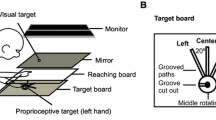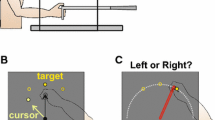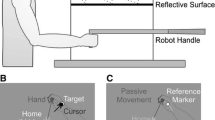Abstract
Previous studies have demonstrated that after reaching with misaligned visual feedback of the hand, one adapts his or her reaches and partially recalibrates proprioception, such that sense of felt hand position is shifted to match the seen hand position. However, to date, this has only been demonstrated in the right (dominant) hand following reach training with a visuomotor distortion in which the rotated cursor distortion was introduced gradually. As reach adaptation has been shown to differ depending on how the distortion is introduced (gradual vs. abrupt), we sought to examine proprioceptive recalibration following reach training with a cursor that was abruptly rotated 30° clockwise relative to hand motion. Furthermore, because the left and right arms have demonstrated selective advantages when matching visual and proprioceptive targets, respectively, we assessed proprioceptive recalibration in right-handed subjects following training with either the right or the left hand. On average, we observed shifts in felt hand position of approximately 7.6° following training with misaligned visual feedback of the hand, which is consistent with our previous findings in which the distortion was introduced gradually. Moreover, no difference was observed in proprioceptive recalibration across the left and right hands. These findings suggest that proprioceptive recalibration is a robust process that arises symmetrically in the two hands following visuomotor adaptation regardless of the initial magnitude of the error signal.







Similar content being viewed by others
References
Abeele S, Bock O (2001) Sensorimotor adaptation to rotated visual input: different mechanisms for small versus large rotations. Exp Brain Res 140:407–410
Baraduc P, Wolpert DM (2002) Adaptation to a visuomotor shift depends on the starting posture. J Neurophysiol 88:973–981
Block HJ, Bastian AJ (2011) Sensory weighting and realignment: independent compensatory processes. J Neurophysiol 106:59–70
Buch ER, Young S, Contreras-Vidal JL (2003) Visuomotor adaptation in normal aging. Learn Mem 10:55–63
Cameron BD, Franks IM, Inglis JT, Chua R (2010) The adaptability of self-action perception and movement control when the limb is passively versus actively moved. Conscious Cogn [Epub ahead of print]
Clayton H, Cressman E, Henriques D (2011) Visuomotor adaptation and proprioceptive recalibration in Ehlers-Danlos Syndrome patients and healthy controls. Society for Neuroscience, Washington, DC
Cressman EK, Henriques DY (2009) Sensory recalibration of hand position following visuomotor adaptation. J Neurophysiol 102:3505–3518
Cressman EK, Henriques DY (2010) Reach adaptation and proprioceptive recalibration following exposure to misaligned sensory input. J Neurophysiol 103:1888–1895
Cressman EK, Salomonczyk D, Henriques DY (2010) Visuomotor adaptation and proprioceptive recalibration in older adults. Exp Brain Res 205:533–544
Criscimagna-Hemminger SE, Bastian AJ, Shadmehr R (2010) Size of error affects cerebellar contributions to motor learning. J Neurophysiol 103:2275–2284
de Grave DD, Brenner E, Smeets JB (2011) Judgments of reachability are independent of visuomotor adaptation. Perception 40:962–974
Goble DJ (2010) Proprioceptive acuity assessment via joint position matching: from basic science to general practice. Phys Ther 90:1176–1184
Goble DJ, Anguera JA (2010) Plastic changes in hand proprioception following force-field motor learning. J Neurophysiol 104:1213–1215
Goble DJ, Brown SH (2008) Upper limb asymmetries in the matching of proprioceptive versus visual targets. J Neurophysiol 99:3063–3074
Goble DJ, Brown SH (2010) Upper limb asymmetries in the perception of proprioceptively determined dynamic position sense. J Exp Psychol Hum Percept Perform 36(3):768–775
Goedert KM, Leblanc A, Tsai SW, Barrett AM (2010) Asymmetrical effects of adaptation to left- and right-shifting prisms depends on pre-existing attentional biases. J Int Neuropsychol Soc 16:795–804
Harris CS (1963) Adaptation to displaced vision: visual, motor, or proprioceptive change? Science 140:812–813
Hay JC, Pick HL Jr (1966) Visual and proprioceptive adaptation to optical displacement of the visual stimulus. J Exp Psychol 71:150–158
Henriques DY, Soechting JF (2003) Bias and sensitivity in the haptic perception of geometry. Exp Brain Res 150:95–108
Jones SA, Cressman EK, Henriques DY (2010) Proprioceptive localization of the left and right hands. Exp Brain Res 204:373–383
Kagerer FA, Contreras-Vidal JL, Stelmach GE (1997) Adaptation to gradual as compared with sudden visuo-motor distortions. Exp Brain Res 115:557–561
Kesten H (1958) Accelerated stochasitc approximation. Ann Math Stat 29:41–59
Klassen J, Tong C, Flanagan JR (2005) Learning and recall of incremental kinematic and dynamic sensorimotor transformations. Exp Brain Res 164:250–259
Krakauer JW, Ghilardi MF, Ghez C (1999) Independent learning of internal models for kinematic and dynamic control of reaching. Nat Neurosci 2:1026–1031
Krakauer JW, Pine ZM, Ghilardi MF, Ghez C (2000) Learning of visuomotor transformations for vectorial planning of reaching trajectories. J Neurosci 20:8916–8924
Martin TA, Keating JG, Goodkin HP, Bastian AJ, Thach WT (1996) Throwing while looking through prisms. II. Specificity and storage of multiple gaze-throw calibrations. Brain 119(Pt 4):1199–1211
Mazzoni P, Krakauer JW (2006) An implicit plan overrides an explicit strategy during visuomotor adaptation. J Neurosci 26:3642–3645
Michel C, Pisella L, Prablanc C, Rode G, Rossetti Y (2007) Enhancing visuomotor adaptation by reducing error signals: single-step (aware) versus multiple-step (unaware) exposure to wedge prisms. J Cogn Neurosci 19:341–350
Ostry DJ, Darainy M, Mattar AA, Wong J, Gribble PL (2010) Somatosensory plasticity and motor learning. J Neurosci 30:5384–5393
Redding GM, Wallace B (1996) Adaptive spatial alignment and strategic perceptual-motor control. J Exp Psychol Hum Percept Perform 22:379–394
Rincon-Gonzalez L, Buneo CA, Helms Tillery SI (2011) The proprioceptive map of the arm is systematic and stable, but idiosyncratic. PLoS One 6:e25214
Salomonczyk D, Cressman EK, Henriques DY (2011) Proprioceptive recalibration following prolonged training and increasing distortions in visuomotor adaptation. Neuropsychologia 49:3053–3062
Simani MC, McGuire LM, Sabes PN (2007) Visual-shift adaptation is composed of separable sensory and task-dependent effects. J Neurophysiol 98:2827–2841
Treutwein B (1995) Adaptive psychophysical procedures. Vis Res 35:2503–2522
van Beers RJ, Wolpert DM, Haggard P (2002) When feeling is more important than seeing in sensorimotor adaptation. Curr Biol 12:834–837
Wei K, Kording K (2009) Relevance of error: what drives motor adaptation? J Neurophysiol 101:655–664
Wilson ET, Wong J, Gribble PL (2010) Mapping proprioception across a 2D horizontal workspace. PLoS One 5:e11851
Acknowledgments
We wish to thank Orysia Kachmarchuk for help with data collection. This work was supported by Canadian Institute of Health Research, Institute of Neurosciences, Mental Health and Addiction and the Banting Foundation (DYPH) and the Natural Sciences and Engineering Research Council (NSERC). DS is supported by an NSERC doctoral scholarship. DYPH is an Alfred P. Sloan Fellow.
Author information
Authors and Affiliations
Corresponding author
Rights and permissions
About this article
Cite this article
Salomonczyk, D., Henriques, D.Y.P. & Cressman, E.K. Proprioceptive recalibration in the right and left hands following abrupt visuomotor adaptation. Exp Brain Res 217, 187–196 (2012). https://doi.org/10.1007/s00221-011-2985-4
Received:
Accepted:
Published:
Issue Date:
DOI: https://doi.org/10.1007/s00221-011-2985-4




